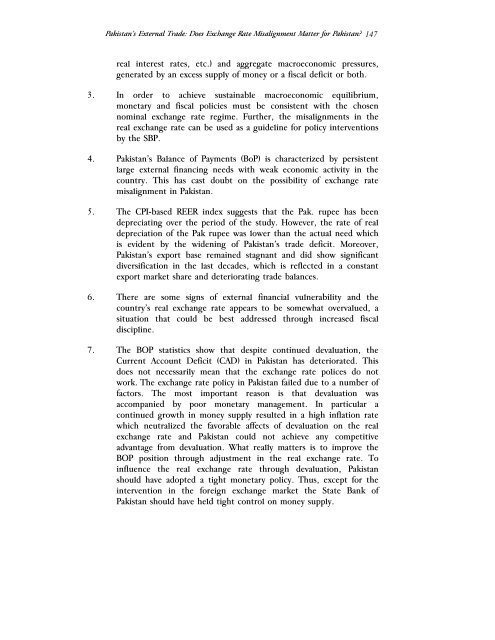Special Edition-07.pdf - Lahore School of Economics
Special Edition-07.pdf - Lahore School of Economics
Special Edition-07.pdf - Lahore School of Economics
You also want an ePaper? Increase the reach of your titles
YUMPU automatically turns print PDFs into web optimized ePapers that Google loves.
Pakistan’s External Trade: Does Exchange Rate Misalignment Matter for Pakistan? 147<br />
real interest rates, etc.) and aggregate macroeconomic pressures,<br />
generated by an excess supply <strong>of</strong> money or a fiscal deficit or both.<br />
3. In order to achieve sustainable macroeconomic equilibrium,<br />
monetary and fiscal policies must be consistent with the chosen<br />
nominal exchange rate regime. Further, the misalignments in the<br />
real exchange rate can be used as a guideline for policy interventions<br />
by the SBP.<br />
4. Pakistan’s Balance <strong>of</strong> Payments (BoP) is characterized by persistent<br />
large external financing needs with weak economic activity in the<br />
country. This has cast doubt on the possibility <strong>of</strong> exchange rate<br />
misalignment in Pakistan.<br />
5. The CPI-based REER index suggests that the Pak. rupee has been<br />
depreciating over the period <strong>of</strong> the study. However, the rate <strong>of</strong> real<br />
depreciation <strong>of</strong> the Pak rupee was lower than the actual need which<br />
is evident by the widening <strong>of</strong> Pakistan’s trade deficit. Moreover,<br />
Pakistan’s export base remained stagnant and did show significant<br />
diversification in the last decades, which is reflected in a constant<br />
export market share and deteriorating trade balances.<br />
6. There are some signs <strong>of</strong> external financial vulnerability and the<br />
country’s real exchange rate appears to be somewhat overvalued, a<br />
situation that could be best addressed through increased fiscal<br />
discipline.<br />
7. The BOP statistics show that despite continued devaluation, the<br />
Current Account Deficit (CAD) in Pakistan has deteriorated. This<br />
does not necessarily mean that the exchange rate polices do not<br />
work. The exchange rate policy in Pakistan failed due to a number <strong>of</strong><br />
factors. The most important reason is that devaluation was<br />
accompanied by poor monetary management. In particular a<br />
continued growth in money supply resulted in a high inflation rate<br />
which neutralized the favorable affects <strong>of</strong> devaluation on the real<br />
exchange rate and Pakistan could not achieve any competitive<br />
advantage from devaluation. What really matters is to improve the<br />
BOP position through adjustment in the real exchange rate. To<br />
influence the real exchange rate through devaluation, Pakistan<br />
should have adopted a tight monetary policy. Thus, except for the<br />
intervention in the foreign exchange market the State Bank <strong>of</strong><br />
Pakistan should have held tight control on money supply.

















